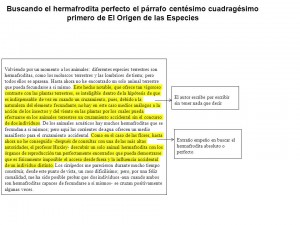![]()
Buscando el hermafrodita perfecto en el párrafo centésimo cuadragésimo primero de El Origen de las Especies

El autor salta de plantas a animales y de animales a plantas. Sigue dando pocos ejemplos y cuando lo hace es de la manera más inapropiada. Así:
De los animales acuáticos hay muchos hermafroditas que se fecundan a sí mismos; pero aquí las corrientes de agua ofrecen un medio manifiesto para el cruzamiento accidental.
141.
Turning for a brief space to animals: various terrestrial species are hermaphrodites, such as the land-mollusca and earth-worms; but these all pair. As yet I have not found a single terrestrial animal which can fertilise itself. This remarkable fact, which offers so strong a contrast with terrestrial plants, is intelligible on the view of an occasional cross being indispensable; for owing to the nature of the fertilising element there are no means, analogous to the action of insects and of the wind with plants, by which an occasional cross could be effected with terrestrial animals without the concurrence of two individuals. Of aquatic animals, there are many self-fertilising hermaphrodites; but here the currents of water offer an obvious means for an occasional cross. As in the case of flowers, I have as yet failed, after consultation with one of the highest authorities, namely, Professor Huxley, to discover a single hermaphrodite animal with the organs of reproduction so perfectly enclosed that access from without, and the occasional influence of a distinct individual, can be shown to be physically impossible. Cirripedes long appeared to me to present, under this point of view, a case of great difficulty; but I have been enabled, by a fortunate chance, to prove that two individuals, though both are self-fertilising hermaphrodites, do sometimes cross.
Volviendo por un momento a los animales: diferentes especies terrestres son hermafroditas, como los moluscos terrestres y las lombrices de tierra; pero todos ellos se aparean. Hasta ahora no he encontrado un solo animal terrestre que pueda fecundarse a sí mismo. Este hecho notable, que ofrece tan vigoroso contraste con las plantas terrestres, es inteligible dentro de la hipótesis de que es indispensable de vez en cuando un cruzamiento, pues, debido a la naturaleza del elemento fecundante, no hay en este caso medios análogos a la acción de los insectos y del viento en las plantas por los cuales pueda efectuarse en los animales terrestres un cruzamiento accidental sin el concurso de dos individuos. De los animales acuáticos hay muchos hermafroditas que se fecundan a sí mismos; pero aquí las corrientes de agua ofrecen un medio manifiesto para el cruzamiento accidental. Como en el caso de las flores, hasta ahora no he conseguido -después de consultar con una de las más altas autoridades, el profesor Huxley- descubrir un solo animal hermafrodita con los órganos de reproducción tan perfectamente encerrados que pueda demostrarse que es físicamente imposible el acceso desde fuera y la influencia accidental de un individuo distinto. Los cirrípedos me parecieron durante mucho tiempo constituir, desde este punto de vista, un caso dificilísimo; pero, por una feliz casualidad, me ha sido posible probar que dos individuos -aun cuando ambos son hermafroditas capaces de fecundarse a sí mismos- se cruzan positivamente algunas veces.

